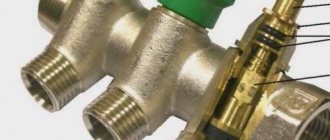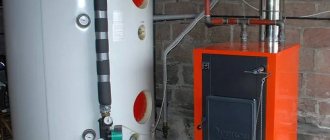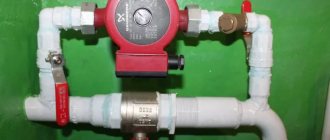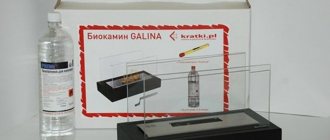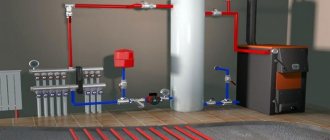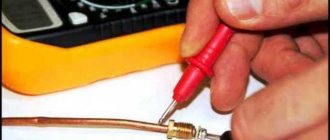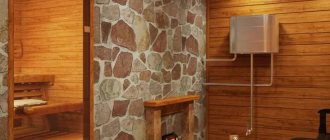Heating elements for heating radiators: comfortable heating
What is a heating element for heating?
Electric heating elements for heating are heating elements that heat the coolant fluid circulating inside the radiator. They are installed on electric radiators made of different materials and alloys - cast iron, aluminum, etc.
Scope of application of heating elements
You can use a heating element for a heating radiator (shown in the photo) when installing autonomous heaters simultaneously with a centralized heating system in order to provide additional heating of the coolant.
Most often, the decision to install a heating element in a battery is made by property owners if the heating in an apartment or house is unstable or is often turned off. This heating device is a good alternative that prevents the building from cooling down and the batteries from defrosting.
Advantages of heating elements
Heating elements (heating elements) have many positive characteristics:
- economy and efficiency - when converting electricity into heat, there is practically no energy loss;
- simple installation - you can even install a heating element for a heating battery yourself and for this you do not need to obtain a special permit from various authorities. Each device is accompanied by detailed instructions from the manufacturer, explaining the connection procedure and operating rules;
- durability - it is achieved through chrome and nickel plating;
- compactness;
- safety;
- an electric heating element with a thermostat for capillary-type heating allows you to regulate the temperature with a high degree of accuracy;
- save energy consumption by allowing the device to operate in pulses;
- affordable price;
- availability of additional functions.
In addition to its positive qualities, a device such as a heating element for heating batteries has several disadvantages:
- high cost of electric heating of residential premises due to electricity prices;
- Not in all settlements throughout the country the electrical power from the substation allows the use of these devices.
Correct choice of heating element model
When going to purchase a heating element, the buyer needs to know a number of technical characteristics:
- required power of the device;
- length, diameter and shape of the tube;
- length of the insulating cap;
- overall length;
- connection type;
- method of fastening.
To calculate the power of a heating element intended for heating water of a certain volume, use the formula:
Solid fuel heating boilers with heating elements
Currently, boilers operating only on solid fuel are rarely used. Instead, the domestic market offers a wide selection of combined and universal heating units that operate not only on solid fuel, but also on other types of energy carriers. A wide range of electric solid fuel heating boilers is offered to consumers.
A heating element solid fuel boiler has the following advantages:
Some models have additional elements:
- A heating element for a 2 kW heating boiler, equipped with a thermostat and a temperature limiter;
- a draft regulator that allows you to automatically regulate the flow of air into the combustion chamber of the device.
In the event of a breakdown, heating elements for heating boilers can be replaced with new products.
Electrode electric boiler
Electrode electric heating boilers are characterized by high productivity and efficiency. Heating of the coolant occurs almost instantly. Hot water begins to flow into the heating system just a few minutes after the electric boiler is turned on.
The efficiency of electrode-type electric boilers is almost 50% greater than that of heating element analogues. There are also disadvantages associated with the internal structure and operating principle.
Design and principle of operation of an electrode boiler
The operating principle of an electrode electric boiler is associated with the direct effect of electric current on the coolant. Heating electrodes are positively and negatively charged. An electromagnetic field is created, under the influence of which the ions begin to move chaotically, with an intensity of at least 50 vibrations per second.
In the process of heating the coolant, electrolysis gas is formed, therefore, from time to time, you will have to bleed the air from the heating system.
The advantage of an electrode boiler is the high efficiency of heating the coolant, due to the absence of intermediaries in heat transfer. There are also limitations. The coolants on which electrode electric boilers operate have a high salt content. You can make your own saline solution, but, as practice shows, it is better to use ready-made mixtures.
The material that makes up the electrode in the boiler must be neutral to scale formation, have good throughput and a long service life. Manufacturers use three types of materials. Budget electric boilers are equipped with graphite and stainless steel electrodes. Premium boilers are equipped with titanium rods.
Types of heating elements in heating systems
As a rule, heating elements for heating a house are used in systems where water or antifreeze becomes the temperature carrier. But there are also air systems with these elements. There are several types of them:
Tubular. The most common. The principle of operation is the exchange of temperatures by convection - the replacement of warm masses with cold ones. Used in electric boilers, water heaters, oil heaters and other units.
Not a single household heating device can do without this element - kettles, all kinds of steamers or washing machines. For clarity, you can see what it is.
Rib or needle heating element. The element has additional ribs along its entire length perpendicular to the axis. Such elements are used in thermal curtains.
As central heating for a residential building, it is too energy intensive. In addition, such elements are fragile compared to tubular options. If damaged, they can only be replaced.
Block and ring view. Their feature is the regulation of the power of the entire element. Designed for heavy industrial loads and inappropriate for a private facility.
You can assemble tubular heating elements yourself. The cost of such a product will be low compared to elements integrated into a factory-type system.
How to choose a heating element for installation in a homemade boiler
For independent work, it is better not to reinvent the wheel, but to buy a ready-made product right away - the price for them is unbeatable
So, what to look for when buying:
- Power. You need to immediately apply the formula - for 10 m², 1 kW of energy is required. Therefore, after making simple calculations, you need to purchase an element of such marking - 10, 20% of the total figure. You should not purchase an element larger than the calculated capacity. Firstly, it is economically unprofitable, and secondly, such power is unlikely to be needed.
- The design is not important. The main thing is that the element enters the heating tank freely, without contact with the walls.
The length is important - short heating elements will not cope well with large amounts of water. It is better if the element parameter does not reach the length of the radiator by 10 cm maximum.
Heating heating elements with a thermostat or control unit are available for sale. If the owners are satisfied with the price, then, naturally, such elements are preferable - they will optimize heating costs. You can set the specified parameters and the temperature will not have to be raised sharply during the peak of cold weather - the room will be sufficiently warmed up at low values. The manufacturer is not so important, unless the product came to us from China. As a rule, individual elements are produced by Türkiye, Poland, and Ukraine. European countries do not produce heating elements regardless of boilers, so if sellers try to sell a German or Italian heating element to a buyer, this is simply a deception.
However, our manufacturers make good options, the service life of which is estimated at tens of years. When producing a homemade installation, you should contact a domestic manufacturer
In general, going to the store unprepared is not a good idea. You should hire a person who understands the essence of the problem as an assistant. The same goes for the work of constructing a makeshift boiler as a whole.
Operating rules
A few simple rules for operation and maintenance will extend the life of the heating element and make its operation more efficient. Here they are:
- If water is used as a coolant, it must be distilled. This will protect you from scale;
- Frequent switching on and off leads to a decrease in service life, so the thermostat must be adjusted accordingly. The minimum difference in water temperature should be at least 5 degrees;
- It is mandatory to use an emergency power cut-off system. This way you can protect other household appliances in the event of a serious breakdown in the heating element;
- It is necessary to deal with voltage surges using a stabilizer or an uninterruptible power supply;
- The appearance of static electricity on the surface of the radiator indicates depressurization of the tube. The heating element must be turned off and removed, otherwise a short circuit is possible, and this means a higher level of problems or material costs.
Failed heating element
What are heating elements and their features
A heating element is a tubular electric heater that can be installed in any container filled with liquid. Many people are probably well aware of the heating element for an oil radiator, which effectively heats up this heating device. In fact, an electric water boiler is such a device.
Electric heating elements for radiators are special devices that can be installed in any heating radiator as a main or additional heat source. As a rule, they are mounted with thermostats that allow the heating process to be automated.
Scheme for using an electric heater as an additional heater
Advice! Heating elements can serve as an emergency source of heating in case of central heating shutdown. In such situations, you can turn off the taps and connect the heater to electricity.
The installation process of these devices is very simple - you just need to unscrew the plug and screw the heater in its place. After this, the radiator can be filled with both water and low-viscosity oil. The latter is best used for cases where the heating is turned on from time to time, for example, in a garage, so that the coolant does not freeze.
The heating element is screwed into the radiator instead of a plug
Advantages
Among the advantages of the device in question are:
- Low cost. however, the price of the heating element itself is usually added to the price of the thermostat, which is supplied separately.
- Easy installation - every home craftsman can install the heater with his own hands, spending only a few minutes of free time.
- If you have a high-quality thermostat, you can completely automate the heating process.
- Electric heaters are quite reliable, durable and absolutely safe. But for this, the connection instructions and safety regulations must be followed.
In the photo - a heating element isolated in a safe housing
Flaws
Along with the advantages, radiator heaters also have some disadvantages:
- High energy costs, especially if heaters are used as the main heater.
- Low heat transfer efficiency. The fact is that the battery heats up unevenly, as it is designed for constant circulation of coolant at high speed.
- A heating element for a radiator with a thermostat and other electronics is more expensive than an oil heater.
Thus, before installing this device, you should consider all its advantages and disadvantages. The fact is that in many cases it is more expedient to use other sources of electrical heating.
Note! Heating efficiency largely depends on the type of heating batteries themselves. For example, cast iron radiators with heating elements are less efficient than, for example, bimetallic or aluminum
Main functions and design of the heating element
The main functions of a heating element mounted in a battery: heating the coolant and, if the heating element is equipped with a thermostat, temperature control.
The heating element for radiators itself is so simple that even a schoolchild can understand its design. An insulated conductive thread is inserted into a metal tube. Most often this is a nichrome spiral. During the galvanization process, the metal tube is coated with chromium or nickel, which gives the metal special protection from the aggressive effects of water and ensures that there is no human contact with electricity. In addition, the housing of the heating element is equipped with control sensors that prevent the device from overheating.
As for the coolant heating function, there are no other options except one: the device is plugged in and the water (or other coolant) is heated. The principle is the same for all electric heating devices.
The thermostat functions are carried out by a heating element equipped with a thermostat. This allows you to set the heating element for radiators to a certain temperature. In addition, there are regulation modes that are simply necessary in certain conditions:
- “Anti-freeze” - maintains a constant coolant temperature of +10 ° C, which does not allow the heating system to freeze.
- “Turbo” is necessary for instant heating of the coolant in an autonomous heating system at maximum power. After reaching the required temperature, the mode automatically turns off and the device operates in accordance with the parameters set by the thermostat.
As for the coolant itself, there is an opinion that the most suitable for batteries equipped with heating elements is transformer oil. It heats up in a short time and gives off heat for a long time.
Materials and tools required for installation
Proper installation of heating radiators by the homeowner himself will require special tools and certain consumables. As for the first and second, their type and size depend on the selected models of heating devices, the method of connecting them, etc. In any case, to install radiators you will definitely need the necessary set of tools and materials.
How to connect a heating radiator with a side connection
Watch this video on YouTube
Tools and accessories
Since all batteries, except for floor-standing devices, are attached to walls, for this you will need to arm yourself with the following:
- perforator;
- drill-driver;
- welding machine for polypropylene pipes;
- hammer;
- level;
- tape measure and ruler;
- marker;
- wrench and pipe wrench;
- socket wrench for assembling sections.
- cord or winding for threaded connections;
- sealant.
Materials
Typically, the manufacturer sells mounting kits for their heating radiators, both for assembling and connecting batteries, and for hanging them on walls. These kits contain the minimum kit required for installation consisting of:
- Brackets.
- Mayevsky tap or automatic air vent.
- Stubs.
- Shut-off valves.
Brackets
They may be included in the delivery kit for radiators. If they are not available, then the necessary fasteners can be purchased at the nearest hardware supermarket.
There are many different designs and shapes of battery supports, but they all have in common a high load-bearing capacity and transfer of the load from the weight of the radiator to the wall. Brackets can be strictly fixed structures and with adjustment mechanisms, both in length and height.
Mayevsky crane or automatic air vent
As the coolant passes through the heating system, the trapped air enters the radiators. This usually happens when the heating system is started at the end of the warm season. Air pockets, if not removed, will restrict the flow of hot water into the upper battery manifold, and it will remain cold.
The Mayevsky tap is a small device that is screwed into a free hole from one side of the upper manifold. If the diameter of the valve differs from the size of the threaded entrance to the manifold, then special adapters are used. A sealant is wound onto the threads of the device
Using a wrench, carefully tighten the tap until it stops.
Air is released by unscrewing the screw or handle. By turning the rings, the direction of the air flow is changed. The air is released until a continuous stream of water appears.
In apartment buildings, it is important to vent the radiators of the upper floors
Automatic machines, according to experts, are rather capricious devices and cannot tolerate contaminated coolant. Over time, the automatic air vent installed in the central heating system begins to leak. Therefore, it is recommended to use them in autonomous heating of private houses, where clean coolant is used.
Stubs
The versatility of radiators with side connections lies in the fact that there are 4 outlets - two each on the lower and upper collector. Two of them, depending on the connection diagram, are occupied by the supply and return pipes.
A Mayevsky tap or automatic air vent is installed in the third hole. A fourth hole remains, which is “plugged” with a screw plug (plug). It is screwed into the hole of the manifold with a wrench with a winding screw (tow, sealing cord or tape) screwed onto the thread.
Shut-off valves
Shut-off valves for heating radiators include three types of taps.
Ball. Used in two extreme positions: “closed” or “open”. They are placed at the input and output of the battery. The role of the shut-off valve is played by a rotating metal ball with a through hole. By turning it with the outer lever, they achieve complete opening or closing of the direct flow of coolant.
Stock This is a traditional scheme for blocking the duct with a movable rod located on the same axis as the rotating head. Unlike a ball device, a rod valve changes the speed of passage of hot water, therefore regulating the degree of heating of the battery.
Check valve. A tap with a check valve cuts off the outflow of coolant in a certain area of the heating system. They are rarely used in centralized heating networks. Most often they are used in particularly complex autonomous heating systems.
Types of heating elements with thermostat
You need to understand that when current is applied to the coil inside the tube, it immediately begins to heat up and cannot turn off on its own. The thermostat monitors the media parameters, turning off the power when the required temperature is reached.
This saves electricity costs and extends the life of the heating element. In this case, there is no connection between the type of heating element and the manufacturer of the thermostat; these two components are packaged together based on economic feasibility.
Three types of heating elements are used for heating.
Tubular electric heater
The most common type, which is found almost everywhere where it is necessary to heat a liquid or the surrounding space.
Peculiarities
The outer tube can be coated with a special composition to resist corrosion and have a bizarre shape. It is possible to select a heating element to suit any request.
Specifications:
- tube diameter from 6 to 20 millimeters;
- length ranges from 0.2 meters to 6;
- metal of manufacture: steel;
- stainless steel;
- titanium;
Advantages and disadvantages
The advantages include:
- high efficiency (about 98%);
- use without additional projects and permits;
- affordable price.
There was also some negativity:
- high cost of heating when using a heating element as the main heater;
- relatively short lifespan;
- the formation of an electromagnetic field that negatively affects human health.
Finned heating element electric heaters
Another type that is used to heat air or gas.
Peculiarities
Metal ribs are attached to a smooth tube, which are located perpendicular to the surface of the heating element. The easiest way to make such a design feature is from a metal strip, which is attached to the base with special nuts.
A heating tube of this shape allows you to remove more heat from the surface; it is often used with a fan that forces air passing through the heating elements.
Advantages and disadvantages
The pros and cons of the device are the same as in the previous version, except that the price is slightly higher. But the efficiency of fins in heating air pays for the costs.
Heating element block
It is considered an industrial option, but is often used at home. This solution will be especially effective when using several low-power heating elements.
Advantages and disadvantages
Pros:
The main positive quality of the design is that if one of the elements burns out, heating of the coolant continues with slightly less efficiency
Therefore, emergency replacement is not required, which is especially important at the height of the heating season when there is frost outside;
The second feature is an increase in power without increasing length, which is vital for some radiator configurations. Problems with heating elements are standard for this type
Added to them is low efficiency when heating air; it is designed for liquids and bulk substances
The problems with heating elements are standard for this type. Added to them is low efficiency when heating air; it is designed for liquids and bulk substances.
Blitz tips
Here are a few recommendations from professionals that will help extend the life of your heating element or avoid mistakes when installing it. So:
- A good place to install a heating element in a radiator is the bottom. This way you can avoid possible air pockets, and therefore overheating;
- When purchasing a heating element, pay attention to the manufacturer’s recommendations for additional sealing;
- When securing the wires to the terminals, you must not apply too much force , otherwise the nut will burst or the tube’s tightness will be compromised;
- When using tap water as a coolant, the heating tube must be removed every 3 months and the deposits must be cleaned off non-mechanically.
A heating element is an electric liquid heater in the form of a metal tube, inside of which there is a spiral. There are many designs and varieties. Heaters are manufactured for both large and small industries.
These heaters are widely installed, for example, in electric boilers and electric boilers, and therefore are also produced by well-known manufacturers.
But in any market you can find heating elements intended for installation in heating radiators. These devices are often manufactured in Poland, Ukraine, and China. They can be equipped with built-in temperature sensors, i.e. work in semi-automatic mode, monitoring the degree of heating.
Based on such electric heaters, you can easily create a heating device with your own hands. This is what home craftsmen use, constructing the simplest heating and, as they think, “saving” a fair amount of money.
But is it really profitable to use heating elements? Where and in what situations are these electric water heaters usually used? How to install and use heating elements...
How big is the benefit from heating elements?
If you have an old battery, then why not use a heating element to turn it into a heating system for a small utility room - a chicken coop, a workshop, a garage...
There are even myths that heating with heaters is beneficial. But “dreams are shattered by harsh reality” - heating with electricity is the most expensive. Since the most expensive energy carrier is used.
Selecting a heating element
When choosing a heating element, you need to pay attention to some details. Only in this case can you count on a successful purchase, high-quality heating, long service life and compatibility of the selected model with the water heating tank. boiler or radiator
boiler or radiator.
Shape and size
There are dozens of heating element models available for buyers to choose from. They have different shapes - straight, round, figure-eight or ear-shaped, double, triple and many others. When purchasing, you should focus on the use of the heater. For installation in sections of heating radiators, narrow and straight models are used, since there is quite little space inside
When assembling a storage water heater, you should pay attention to the volume and shape of the tank, and based on this, choose a suitable heating element. In principle, almost any model will fit here. If you need to replace a heating element in an existing water heater, you need to purchase an identical model - only in this case can you count on it fitting into the tank itself
If you need to replace a heating element in an existing water heater, you need to purchase an identical model - only in this case can you count on the fact that it will fit into the tank itself.
Power
If not everything, then a lot depends on power. For example, this could be the heating rate. If you are assembling a small-volume water heater, the recommended power will be 1.5 kW. The same heating element will be able to heat disproportionately large volumes, but it will do this for a very long time - with a power of 2 kW, heating 100-150 liters of water can take 3.5 - 4 hours (not to a boil, but on average by 40 degrees).
If you equip a water heater or water tank with a powerful 5-7 kW heating element, the water will heat up very quickly. But another problem will arise - the house electrical network will not withstand it. When the power of the connected equipment is above 2 kW, it is necessary to lay a separate line from the electrical panel.
Protection against corrosion and scale
When choosing heating elements for heating water with a thermostat, we recommend paying attention to modern models equipped with scale protection. Recently, models with enamel coating have begun to appear on the market. It is this that protects heaters from salt deposits.
The warranty on such heating elements is 15 years. If you don’t find similar models in the store, then we recommend purchasing electric heaters made of stainless steel - they are more durable and reliable
It is this that protects the heaters from salt deposits. The warranty on such heating elements is 15 years. If you don’t find similar models in the store, then we recommend purchasing stainless steel electric heaters - they are more durable and reliable.
The presence of a thermostat
If you are assembling or repairing a boiler or want to equip a heating element with a heating element, choose a model with a built-in thermostat. It will save on electricity by turning on only when the water temperature drops below a set point. If there is no regulator, you will have to monitor the temperature yourself by turning the heating on or off - this is inconvenient, uneconomical and unsafe.
Replacement algorithm
Replacing a heating element in a water heater is a very labor-intensive operation and is carried out strictly according to certain regulations:
- disconnect the product from the electrical network;
- drain the water completely;
- remove the water heater from its mounts and turn it over for ease of carrying out all work;
- Unscrew the fastening of the bottom panel, photograph the location and order of wiring;
- disconnect the wires from the heating element and remove it from the tank body;
- clean the plaque and scale; if no damage to the housing is found, then install the heating element in place;
- in case of replacement, install a new heating element and reassemble in the reverse order.
Especially for inexperienced users, to help them carry out this operation correctly, there is a video where an experienced technician replaces the heating element in a boiler:
Block heaters
Block options are several tubular-type heaters that are combined into one block and usually have one fastening element
When choosing a particular block heater, you should pay attention to the power ratings and the ability of the boiler equipment and pump to provide effective heat removal
It is recommended to give preference to these types if:
- you need to use a device with high power and heating rate of the environment;
- there is no way to quickly transfer heat energy from the working coil to the medium due to the small area of the heating element shell on the outside.
The advantage of the block solution is the ability to reduce the load on each tube, which simultaneously increases the uniformity of heating of the medium and causes little wear on the heating elements located inside these tubes.
View products
As for power, models can provide from 5 to 10 kilowatts. So, during the installation of equipment with block heating elements, you will have to take care of laying an additional electrical cable.
The amount of electricity kWh and the cost of heating water.
The calculator will calculate the heating time of water in storage water heaters depending on the capacity of the tank, the power of the heating elements, the heating temperature and the temperature of the incoming water.
You can specify the efficiency of the storage water heater (usually 95-99%).
Calculator taken from the site: https://nagrev24.ru/voda
Electricity is converted into heat and the efficiency depends on the material of the heating element (on the loss of electricity in it and on thermal conductivity), on the area of contact of the element with water, the contact resistance of the contacts and losses in the power cord. At each stage some energy is lost. Depending on the type of device, the efficiency is in the range of 95-99%.
The more effective the thermal insulation properties of the material separating the internal tank from the environment, and the thicker its layer, the more economical the water heater. Modern boilers guarantee a decrease in water temperature of no more than 0.25 - 0.5 degrees per hour and electricity consumption of less than 1 kW/h per day in standby mode.
The most optimal operating temperature for the water heater is 55-60°C. This reduces power consumption to maintain the temperature of hot water, reduces the formation of scale, and provides a more gentle regime for the internal tank.
How not to make a mistake in choosing
Radiators for heating elements are quite simple to choose, since they do not require a special variety of designs and technical characteristics. Please consider the following points before purchasing.
Electric heating element power calculation
In order to correctly determine the required power of the device, it is advisable to know the thermal standards in force in the given area. As a last resort, you can use the average indicator, which can be used in central Russia and make some adjustments if necessary.
Based on this, for 10 sq. meters of heated area, provided that the heating element will be used as the main heating, 1 kW of its power is required.
If heating elements for radiators are chosen as the main heating for the home, it is highly advisable to purchase models with a thermostat. In this way, it will be possible to regulate the power of the device and thereby reduce energy costs
If the device is used as additional heating, the required power will be 3-4 times lower. In addition, when choosing a device, you should take into account the specifics of the radiator heating element.
Due to its design features, it will be able to operate uninterruptedly only at 75% of the heat transfer from the radiator. With higher power, the device will overheat and it will constantly turn off.
Based on this, the power of the device is calculated. The exact heat transfer values of a particular radiator can be found in its technical documentation. However, on average, one section of an aluminum battery has a heat output of 180 W, and a cast iron battery has a heat output of 140 W.
Let us calculate, as an example, which heating element is suitable for a 10-section radiator. We multiply the data by 10 and we get that for an aluminum battery it is worth taking a heating element with a power of up to 1.35 kW, for a cast iron battery - up to 1 kW.
Design features of the device
For each radiator, you should select a heating element that is suitable for it in size and thread direction. The equipment has different shaft lengths, which may affect its performance.
If the length of the heating element is insufficient, the equipment is not able to provide a sufficiently high circulation rate of the coolant, as a result of which the heating of the radiator will be uneven and insufficient.
The length of the device is perhaps one of its most important characteristics, which directly affects its efficiency. Before purchasing, you should measure the radiator and calculate the required length of the built-in heating element
The optimal option is when the heating element rod does not reach the inner wall of the opposite edge of the radiator by 60-100 mm
It is also important to choose the right body shape and diameter of the device.
The material of the plug may vary between models. To make the right choice, you should study the manufacturer’s recommendations, where he describes the types of heating devices suitable for using a particular heating element.
Availability of automatic control
Devices are available for sale with or without built-in automatic control. The first variation is as convenient as possible and does not require the purchase of additional equipment. In this case, a thermostat with a sensor that measures the temperature of the coolant is built into the lower part of the heating element housing.
If there is no built-in automation, the electrical appliance does not have a thermostat. In this case, it is advisable to connect using a detector that measures the air temperature in the room.
It must be admitted that this equipment is not so popular and in demand for large European companies to start producing it.
In stores you can find radiator heating elements made by Turkish, Polish and Ukrainian brands. In terms of quality and functionality, they are approximately similar.
It is difficult to say which company's products should be preferred. But you need to be wary of Chinese heating elements, since you can often get a low-quality product.
Cosine phi for various consumers - table
| Name of electrical appliance | cos φ |
| Boiler | 1 |
| Bulgarian | 0.8 |
| Vacuum pump | 0.85 |
| Induction furnaces | 0.85 |
| Compressor | 0.7 |
| Computer | 0.95 |
| Coffee maker | 1 |
| Gas discharge lamps | 0.4-0.6 |
| Fluorescent lamps | 0.95 |
| Incandescent lamps | 1 |
| Heater | 1 |
| Hammer | 0.85 |
| Vacuum cleaner | 0.9 |
| Microwave | 1 |
| Washing machine | 0.9 |
| TV | 1 |
| Iron | 1 |
| Hairdryer | 1 |
| Fridge | 0.95 |
| Electric drill | 0.85 |
| Electric motors | 0.7-0.8 |
| Electric stove | 1 |
| Electric arc welding | 0.3-0.6 |
| Electric kettle | 1 |
How to choose a heating element for heating equipment?
When choosing a heating element to replace in a water heater or radiator, you need to pay attention to its power, design, tube length and the availability of additional capabilities. Therefore, before purchasing, you need to find out as much as possible about all its characteristics.
Calculation of device power
The high power of a heating element is not always a positive quality.
When choosing, it is important to consider several factors that are related to the level of energy consumption:
- maximum heat transfer power of the heating device as a whole;
- electrical wiring options;
- room volume.
You cannot buy a device with a power that is more than 75% of the maximum heat transfer level of heating equipment.
For example, there is a radiator with 10 sections, each of which releases 150 W of heat to the air, a total of 1.5 kW. When installing an electric heater with a power of 2 kW into it, the surface of the battery will not be able to quickly release all the energy generated. As a result, the heating element will constantly turn off due to overheating.
The reason for the rapid breakdown of the heating element may be the incorrect choice of device power. As a result of systemic overheating of the coil, it burns out over time.
In apartments with worn-out wiring, the constant load on the outlet should not exceed 1.5-2 kW, otherwise it may catch fire and lead to dire consequences. Therefore, before purchasing a heating element, you need to check the condition of the wiring and, if necessary, dismantle the old one and install a new electrical network.
When the issue with electrical equipment and equipment capabilities has been resolved, you can begin to calculate the required power to maintain a comfortable temperature in the room.
In well-insulated houses and apartments, a level of 40 W/m3 will be sufficient. And if there are cracks in the windows, the heating power should be increased to 60-80 W/m3. You can buy a specific model only after taking into account all the energy factors described above.
Consideration of design features
Most heating elements have an alloy steel shell, which provides strength and resistance to corrosion. Copper devices are used primarily in water heaters, although there are no restrictions on their use in homemade radiators.
In cast iron and steel radiators, the use of heating elements made of non-ferrous metals is undesirable. This can lead to accelerated wear of materials and connections.
Also, when choosing, it is necessary to take into account the direction of the thread of the plug, which can be right or left. Different models of electric heaters also differ in flange diameter. They can range in size from 0.5 to 1.25 inches.
Typically, a heating element from a good manufacturer comes with a brief instruction manual that describes its design parameters. Studying them will help you buy a device that will exactly fit your existing heating equipment.
Heating tube length
The length of the tube is one of the main characteristics that determine the efficiency of the device.
Its large length with equal power leads to an increase in the surface area of the electric heater and acceleration of heat exchange with the working environment. This has a positive effect on the durability of the heating element and the coolant circulation rate.
Heating elements with a long tube are ideal for installation in homemade registers, which are convenient for heating large rooms and outbuildings
It is desirable that the tube runs along the entire length of the working area of the heating device, without reaching the opposite wall by 6-10 cm. This recommendation will allow you to quickly and evenly warm up the coolant.
Availability of additional functionality
It is not always necessary to overpay for the additional capabilities of heating elements. If the heating device is used as an auxiliary device and does not have its own built-in automation, then purchasing a model with a thermostat makes sense.
But if a radiator or electric convector has its own temperature sensors and temperature control mechanisms, additional functions will remain unclaimed.
The electronics built into the heating element plug must have safety mechanisms so that if the control board breaks down, a fire does not occur.
Therefore, it is recommended to purchase expensive electric heaters with built-in automation only if there is a clear need for such equipment. If you need to individually select the temperature background, it is better to buy a thermostat for an outlet that can be used periodically.
As for the manufacturers of heating elements, their choice is not important. The main suppliers are companies from Russia, Ukraine, Turkey and Italy. The quality of their products is approximately the same, so there is no point in overpaying for the brand.
Instantaneous water heaters
When calculating the amount of heat for heating running water, it is necessary to take into account the difference in voltage standards in Russia (220 V) and Europe (230 V), since a significant part of electric water heaters are manufactured by Western European companies. Thanks to this difference, the nominal value of 10 kW in such a device when connected to a Russian 220V network will be 8.5% less - 9.15.
The maximum hydroflow V (in liters per minute) with given power characteristics W (in kilowatts) is calculated by the formula: V = 14.3*(W/t2-t1), in which t1 and t2 are the temperatures at the inlet to the heater and as a result heating accordingly.
Approximate power characteristics of electric water heaters in relation to domestic needs (in kilowatts):
- 4−6 – only for washing hands and dishes,
- 6−8 – for taking a shower,
- 10−15 – for washing and showering,
- 15−20 – for complete water supply to an apartment or private house.
The choice is complicated by the fact that the heaters are available in two connection options: to a single-phase (220 V) and three-phase (380 V) network. However, heaters for single-phase networks, as a rule, are not produced above 10 kilowatts.



